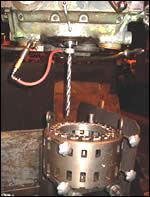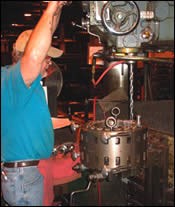Drill Cuts Cycle Time, Costs By More Than 60 Percent
This supplier of engineered gear and drive systems had problems with tool life and lengthy cycle times when drilling holes on a large drive shaft made of forged alloy steel. A new drilling system resolved these issues and exceeded the company's expectations.
Share





Oerlikon Fairfield Drive Systems supplies engineered gear and drive systems to off-highway and industrial equipment manufacturers from around the world. As a branch of Oerlikon, the Lafayette, Indiana-based company specializes in the design, development and manufacture of custom gear and drive assemblies for numerous industries, including construction, mining, rail, transportation and agriculture.
Fairfield vies with both foreign and domestic machine shops to stay at the forefront of the industry. To remain competitive, the 88-year-old company constantly seeks ways to streamline its production process. When Fairfield began experiencing issues with producing drive shafts for mining equipment, the company realized that finding an effective solution to its problematic production process would be vital to its success.
The problem involved a large drive shaft constructed of forged alloy steel. The company ran this application on a Carlton Radial Arm Drill with water-soluble coolant using a rotary coolant adaptor (RCA). The operation required drilling 10-inch deep, 0.787-inch diameter holes. To machine the holes, the company used a cobalt twist drill and a fixture plate with 0.787-inch bushings in a process that took 17 minutes, 33 seconds. This lengthy cycle time limited productivity and drove up costs, leading the company to search for a quicker solution.
Fairfield consulted Allied Machine & Engineering Corporation. Allied field sales engineer Chad Longstreth, along with Indianapolis-based distributor Carbide, Cutting Tools, and Abrasives Inc. (CCA), brought in Allied’s GEN2 T-A drilling system to address the company’s concerns. Since this implementation, the company reports that the 0.787-inch drill insert exceeded its expectations.
Featuring a chrome helix holder, the new insert uses a bushing fixture for guidance when the tool transitions from one set of holes on the top of the part to another set of holes on the bottom.
“The bushing simply keeps the holes in line,” Mr. Longstreth explains.
Another feature designed to maintain hole straightness is the insert’s custom notch-point geometry. The insert’s design, coupled with its custom AM200 coating, increase tooling life and drill stability, the manufacturer says. In addition, the tool is designed to provide smooth breakouts in through-holes while improving chip formation.
Addressing the benefits of the GEN2 T-A tooling, Mr. Longstreth explains, “The previous process was very tedious, and tool life was minimal. Additionally, the tool required frequent re-sharpening, which detracted from machining and therefore added to production costs.”
With the capability to drill 24 holes before wear sets in, the new drill is an obvious upgrade from the previous tool, which lasted for only ten holes, the company says. The tool reduced the operation’s cycle time by nearly 64 percent to only 6 minutes and 35 seconds.
This cycle-time reduction and longer tool life has created a substantial cost savings for Fairfield. The company lowered its costs by roughly 63 percent when drilling 600 holes with the new tool, a savings that amounted to thousands of dollars.
“Having the ability to make it through an entire part without changing the drilling insert maximizes uptime and minimizes costs,” Mr. Longstreth concludes.
Related Content
Custom PCD Tools Extend Shop’s Tool Life Upward of Ten Times
Adopting PCD tooling has extended FT Precision’s tool life from days to months — and the test drill is still going strong.
Read MoreForm Tapping Improves Tool Life, Costs
Moving from cut tapping to form tapping for a notable application cut tooling costs at Siemens Energy and increased tool life a hundredfold.
Read MoreHow to Mitigate Chatter to Boost Machining Rates
There are usually better solutions to chatter than just reducing the feed rate. Through vibration analysis, the chatter problem can be solved, enabling much higher metal removal rates, better quality and longer tool life.
Read MoreShoulder Milling Cuts Racing Part's Cycle Time By Over 50%
Pairing a shoulder mill with a five-axis machine has cut costs and cycle times for one of TTI Machine’s parts, enabling it to support a niche racing community.
Read MoreRead Next
Setting Up the Building Blocks for a Digital Factory
Woodward Inc. spent over a year developing an API to connect machines to its digital factory. Caron Engineering’s MiConnect has cut most of this process while also granting the shop greater access to machine information.
Read MoreRegistration Now Open for the Precision Machining Technology Show (PMTS) 2025
The precision machining industry’s premier event returns to Cleveland, OH, April 1-3.
Read MoreBuilding Out a Foundation for Student Machinists
Autodesk and Haas have teamed up to produce an introductory course for students that covers the basics of CAD, CAM and CNC while providing them with a portfolio part.
Read More
















.png;maxWidth=300;quality=90)


















